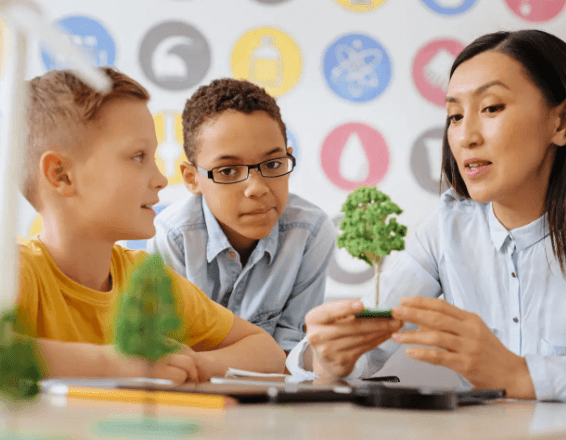Sustainability Education and Climate Literacy: Empowering the Next Generation

As climate change continues to impact every facet of our lives, sustainability education and climate literacy have become essential components of modern education systems. These concepts aim to equip individuals with the knowledge and skills necessary to understand environmental issues, mitigate their effects, and adopt sustainable practices that promote the long-term well-being of the planet. In 2024, the urgency of addressing climate change has prompted governments, educational institutions, and organizations to prioritize sustainability education, creating a movement to foster environmental stewardship and climate-conscious behavior.
This article explores the growing importance of sustainability education, the role of climate literacy in combating global warming, and how these initiatives are shaping the future of education and society.
What is Sustainability Education?
Sustainability education refers to teaching students about the principles of sustainable development, which balance environmental protection, economic growth, and social equity. It focuses on the interconnectedness of human activities and the natural world, emphasizing the need for a balanced approach to resource consumption, waste management, and environmental conservation.
Sustainability education is not limited to environmental science but extends to economics, politics, and social justice, integrating various disciplines to offer a comprehensive view of how human actions impact ecosystems. By understanding this interdependence, students can become agents of change, capable of contributing to a more sustainable future.
See also: STEM Education and Digital Skills for the Future: Preparing the Next Generation
The Role of Climate Literacy
Climate literacy is the understanding of climate science and the human impact on the Earth’s climate system. It includes knowledge about the causes of climate change, such as greenhouse gas emissions, the effects of rising global temperatures, and potential solutions to mitigate these effects.
A climate-literate individual can:
- Understand the science behind climate change and its effects on weather patterns, sea levels, biodiversity, and human health.
- Analyze environmental data to make informed decisions about sustainability practices.
- Advocate for policies and lifestyle changes that reduce carbon footprints and promote sustainability.
Incorporating climate literacy into education prepares students to engage with complex environmental challenges and empowers them to take responsible action in both their personal and professional lives.
Why Sustainability Education and Climate Literacy Matter
In 2024, the need for sustainability education and climate literacy has never been more pressing. From extreme weather events to global resource shortages, the effects of climate change are becoming increasingly visible, making it imperative that individuals and communities understand how to adapt and mitigate these challenges. By teaching students the principles of sustainability and climate science, we can foster a generation that is better prepared to handle the environmental, economic, and social impacts of a changing planet.
1. Addressing the Climate Crisis
The world is already seeing the consequences of climate change, from devastating wildfires and hurricanes to widespread biodiversity loss. Education is a critical tool in combatting these issues, as it helps individuals understand the root causes of climate change and empowers them to take action.
For example, climate literacy programs teach students about renewable energy solutions, carbon footprints, and sustainable agriculture practices. By learning how to reduce greenhouse gas emissions and adopt environmentally friendly behaviors, students can become part of the solution to the climate crisis.
2. Promoting Sustainable Development Goals (SDGs)
Sustainability education is closely aligned with the United Nations’ Sustainable Development Goals (SDGs), particularly SDG 4.7, which calls for education that promotes sustainable development and global citizenship. By integrating climate literacy into curriculums, schools can help students understand how sustainability intersects with economic development, social equity, and environmental health.
Through this lens, students learn how their actions influence global issues such as poverty, inequality, and resource depletion, fostering a mindset that encourages sustainable consumption and production patterns.
3. Preparing for Green Jobs
As industries shift toward green economies, the demand for professionals with expertise in sustainability is growing rapidly. Fields such as renewable energy, sustainable agriculture, waste management, and environmental engineering are seeing increased job opportunities. By embedding sustainability education and climate literacy in school curriculums, students are better prepared for the green jobs of the future.
Incorporating STEM (Science, Technology, Engineering, and Mathematics) education into sustainability programs further ensures that students gain the technical skills needed to drive innovation in areas such as clean energy, circular economy, and environmental policy.
Key Components of Sustainability Education and Climate Literacy
To be effective, sustainability education and climate literacy need to address several core components:
1. Climate Science
Understanding the science behind climate change is foundational to climate literacy. This includes learning about the carbon cycle, the role of fossil fuels in greenhouse gas emissions, and the impact of human activities on global warming. Students need to grasp basic climate models, predictions, and data interpretation to understand the consequences of rising global temperatures.
2. Ecological Footprint
Students should be educated on how personal consumption habits contribute to their ecological footprint. This includes understanding the environmental impact of energy use, transportation, food choices, and waste. By learning about their footprint, students can adopt more sustainable practices, such as reducing waste, choosing renewable energy sources, and supporting sustainable products.
3. Environmental Justice
Sustainability education should also highlight issues of environmental justice, which explores how climate change disproportionately affects marginalized communities. Students need to understand the social dimensions of climate change and sustainability, including how race, class, and geography influence vulnerability to environmental degradation and access to resources.
4. Problem-Solving and Critical Thinking
A key goal of sustainability education is to develop problem-solving skills. Students should be encouraged to think critically about global challenges, such as water scarcity, deforestation, and pollution, and develop innovative solutions to these problems. Project-based learning, where students engage in real-world sustainability projects, is an effective way to build these skills.
Innovative Approaches to Teaching Sustainability and Climate Literacy
Many educational institutions are developing creative approaches to make sustainability education engaging and impactful. These include:
1. Outdoor and Experiential Learning
Outdoor learning experiences allow students to interact directly with nature and witness the effects of environmental changes. Field trips to conservation sites, renewable energy plants, or farms practicing sustainable agriculture provide hands-on learning opportunities that reinforce classroom lessons.
2. Gamification and Digital Tools
Innovative EdTech platforms are incorporating gamification into sustainability education. Through interactive simulations and games, students can explore the impacts of climate change and experiment with solutions. For example, Climate Interactive and Eco-Schools offer digital tools that allow students to simulate policy decisions and observe their environmental outcomes.
3. Community Engagement
Sustainability education programs often extend beyond the classroom, encouraging students to take action in their local communities. From participating in tree-planting initiatives to organizing community recycling programs, students learn to apply their knowledge in ways that have tangible, positive impacts on their surroundings.
Challenges and Opportunities
Despite the growing focus on sustainability education, several challenges remain:
- Access and Equity: Not all students have equal access to sustainability education, particularly in low-income areas where resources are limited. Governments and NGOs must work to provide schools with the tools and funding necessary to implement effective climate literacy programs.
- Curriculum Integration: For sustainability education to be effective, it must be integrated across subjects, rather than being treated as a standalone topic. This requires a shift in how schools approach interdisciplinary learning, ensuring that sustainability principles are woven into science, economics, social studies, and more.
At the same time, these challenges present opportunities to innovate and improve education systems. By fostering public-private partnerships, investing in teacher training, and leveraging digital tools, sustainability education can be expanded and improved globally.
Conclusion
Sustainability education and climate literacy are essential for preparing the next generation to tackle the environmental challenges of the 21st century. By teaching students the science behind climate change, the principles of sustainable development, and the skills needed to innovate solutions, we can empower them to become leaders in building a more sustainable future.
As climate change continues to disrupt ecosystems and economies, the importance of educating for sustainability will only grow. By making sustainability a core component of education, we ensure that future generations are equipped with the knowledge, skills, and values necessary to protect the planet and promote social equity.




